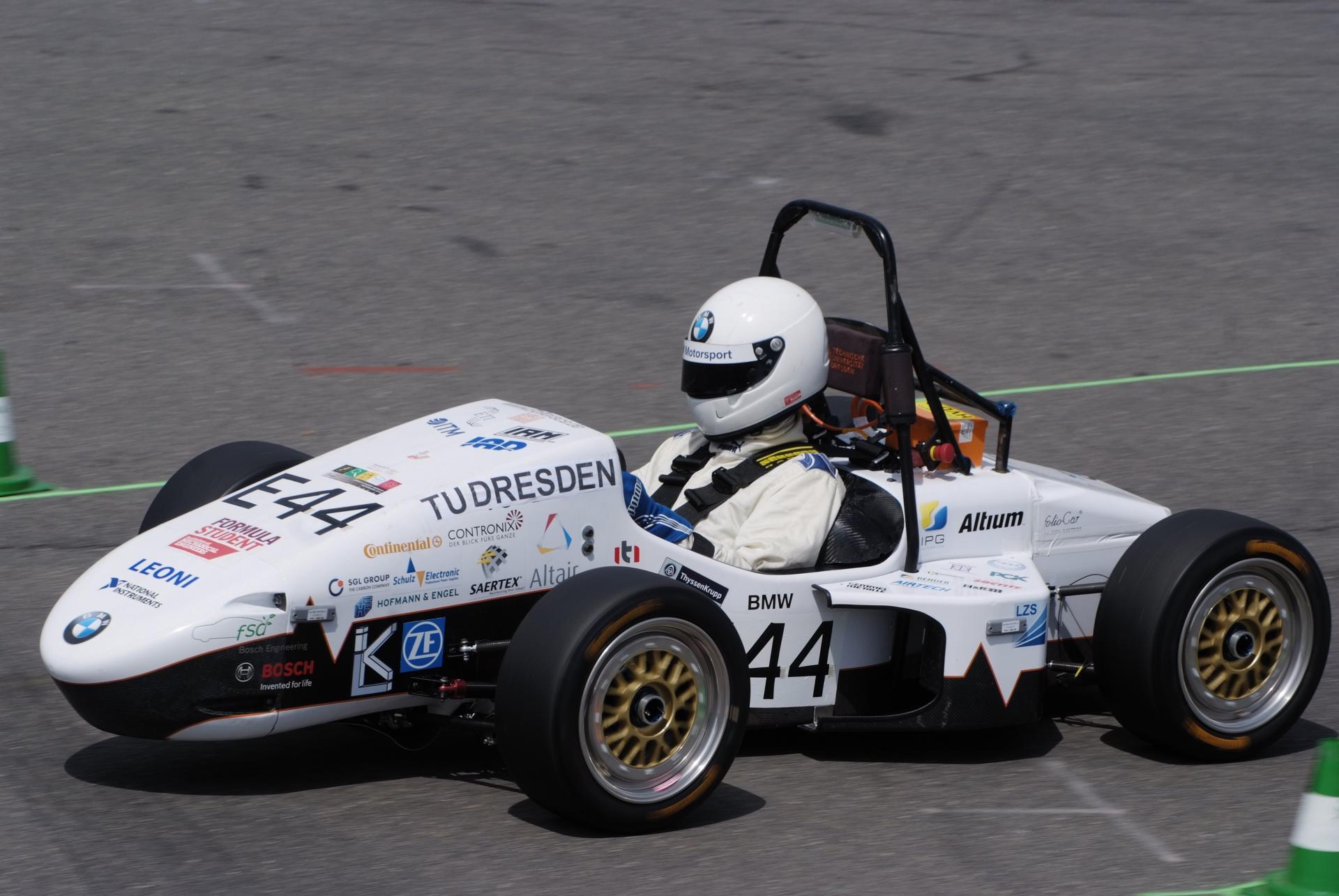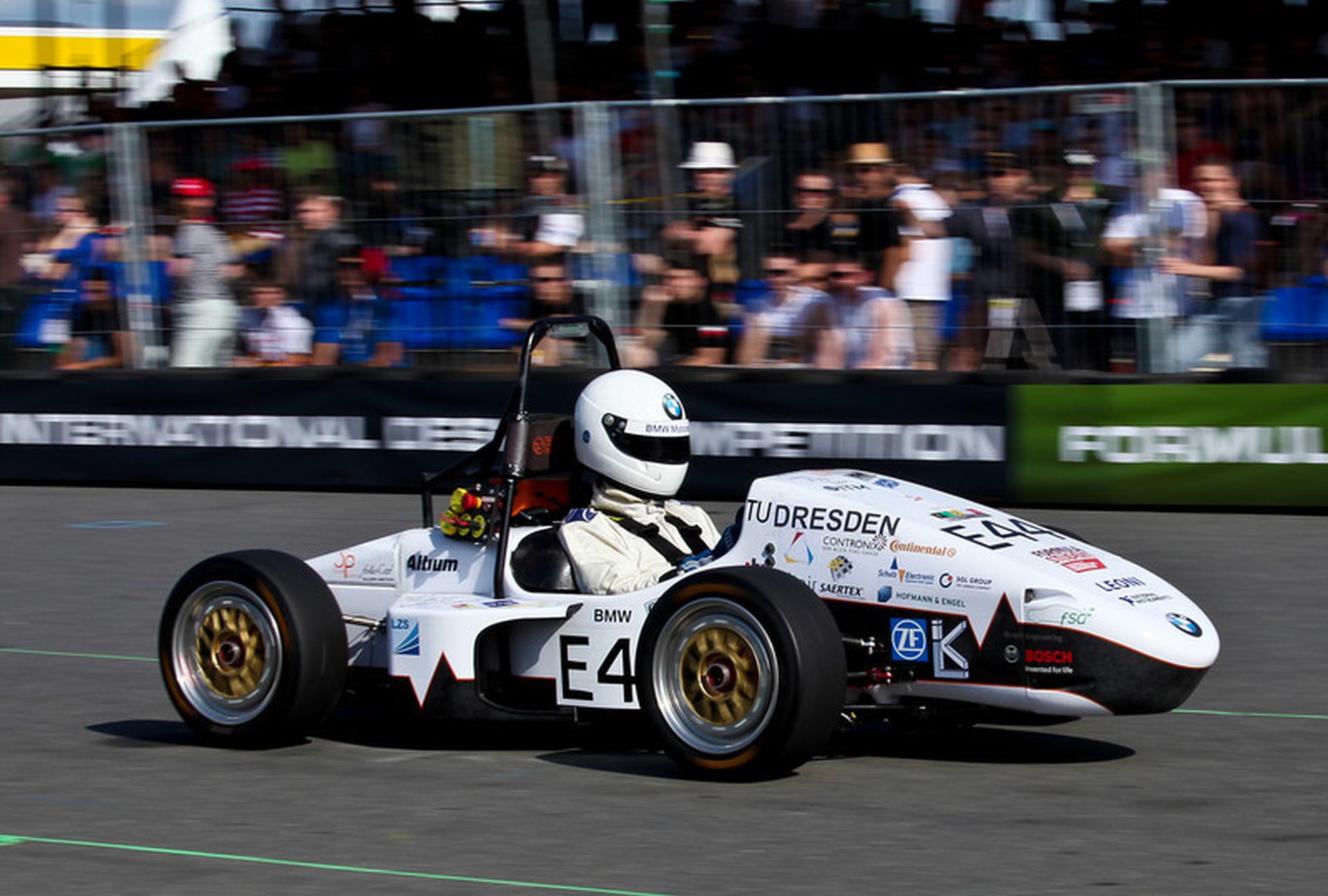MurphE


Key Facts
| Weight: | 240 kg |
| Engine Power: | 2 x 36 kW |
| Voltage: | 450 V |
| Acceleration (0-100 km/h): | < 4.0 sec |
| Maximum Velocity: | 130 km/h |
Electronics
The main feature of Murph-E’s electronics is the considerably reduced sensitivity to interference. This is due to the Smart Sensor concept, which involves the transformation of the sensor signal into the CAN protocol, and due to the EMC housing concept. For this we have placed 4 of the Smart Sensor circuit boards at the particular points in the car (on the pedal box, on the cooling system, on the motors) where they can support and utilise nearby sensors. The data receiver is a National Instruments sbRIO, like the previous year. The board is housed in an aluminium box, which is unsusceptible to external electromagnetic influence due to appropriate sealing and connections. In order to receive the relevant data quickly, we placed the data links, where the control unit, the BMS and sbRIO can be activated and data uploaded to the CAN, in the firewall. So the driver can get the data too without taking a detour, the steering wheel has an integrated display, which was built around the Smart Sensor boards. Using 3 dials certain driving dynamic controls can be changed so that the car can be adjusted according to the conditions.
Electric Drivetrain
This year essential characteristics of the drive system were ascertained with the help of our energetic longitudinal dynamics simulation. In addition experiences from the first electro-season were used, which heavily influenced the design. The motor/inverter package was from another manufacturer, which reduced the application time to a minimum and significantly simplified drive train failure diagnostics. Using knowledge from the previous year’s BMS, this was further developed this year to protect the cells from reaching unacceptable operating conditions. The battery is composed of lithium polymer pouch cells, which are optimally utilised by our load requirements.
Technical facts drivetrain:
(1) Engine
- Siemens 1FE1064-6WN11-1BA2
- water cooled, brushless synchronous machine with radial-flux arrangement
- Maximum torque: 105Nm
- Maximum revolutions: 8000 rpm
- Maximum engine output: ~36kW
(2) Inverter
- Siemens 6SL3126-1TE28-5AA3
- self-developed water-cooling
- Maximum output current: 141 A
(3) Traction battery
- 330 Lithium Polymer cells
- interconnection: 108s3p
- Maximum Voltage: 450V
- Capacity: 5,2kWh
- Self-developed battery management system
- DC/DC converter to supply low voltage systems
- Self-developed maintenance plug for fast disconnection of the batteries for maintenance
Propulsion
The mechanical drivetrain consists of the drive unit, which contains the motors and gearbox, the drive shafts, and connections as well as the cooling for the motors and inverter. The components were designed and selected based on the longitudinal dynamics simulation.
Drive unit:
- Modular housing for motors and gearbox made from aluminium
- Single assembly for simple construction outside of the vehicle, for assembly tests and fast maintenance.
- Motors installed transversely at the rear
Gear box:
- one gear box per engine
- transmission ratio: 1:4,63
- Gears with hybrid construction: sprocket and tripod support made from steel, adaptor from aluminium.
Drive shafts:
- made out of steel
- Tripod-joints
cooling
- circuit with two radiators and pumps
Suspension
With Murph-E, the existing kinematics of the independent suspension was adapted with double wishbones to the new monocoque. This provides the right camber gain in compression to get the most from our tyres.
Through targeted optimisation of particular components, e.g. the uprights and the Y-inserts for the wishbones, we could reduce the weight of the vehicle. Thanks to the new position of the steering gear, which is now under the monocoque, and the dampers on the side of the car, we could lower the centre of mass by about 25mm and improve the transverse dynamics.
Further important features of our chassis can be found in the following list:
- radial ply tyres from Continental on BBS rims with central lock
- topology optimised, milled uprights made from aluminium
- brake system with self manufactured steel brake discs in combination with 4/2 cylinder fixed calipers from Wilwood
- double wishbones made from carbon fibre tubes with aluminium inserts
- Milled suspension brackets made from high-strength aluminium
- progressive steering gear box from PSS
- special Formula Student dampers from ZF Sachs with H&R motorsport springs
- adjustable tubular anti-roll bars on front and rear axes
Chassis
In the second year with an electrical motor, particular value was put on further development and optimisation. The goal is to adapt our car to smaller drive components to make it overall easier to make. Based on the foundations of motorsport – speed and handling – there is also another goal: to build an ergonomic and easy to access monocoque and cockpit. Easy access to all components is as important to us as chassis conditions for optimal driving characteristics. Building on the experience of the previous season, a multi-part carbon fibre monocoque is to be manufactured. For the production of our structure, we want to use prepreg plies, which will be cured in an autoclave under temperature and pressure.
